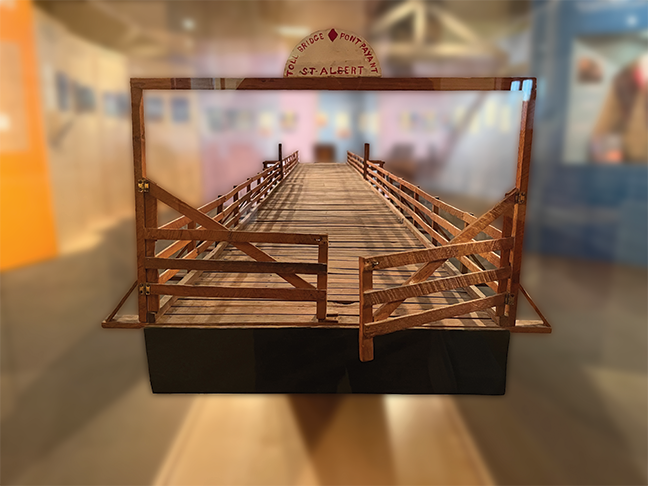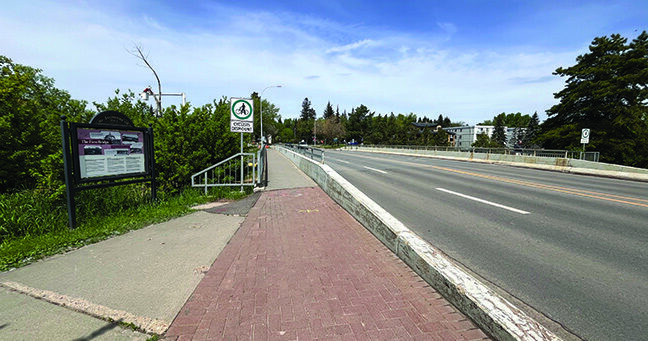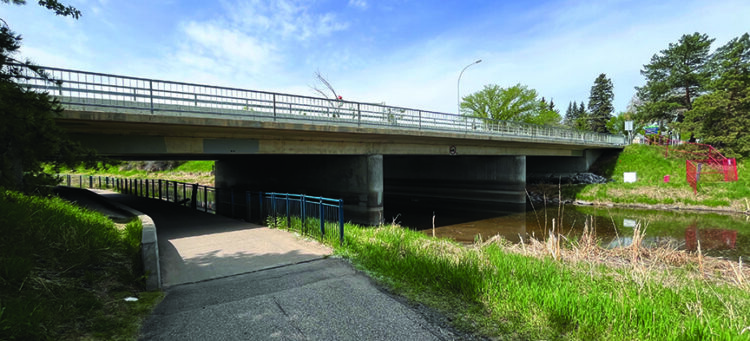Then & Now
Sturgeon River Bridges
Gene Kosowan PHOTOGRAPHY: Paula E.Kirman
July, 2024
Credit the Perron Street Bridge for first connecting St. Albert with the world
Considering that the St. Albert Trail bridge is the most widely used way to get across the Sturgeon River, locals might easily forget that it wasn’t the first project built for the task. That distinction goes to the relatively smaller Perron Street Bridge, which more than 160 years ago, not only made it easier for residents to traverse the river, it also opened St. Albert to the region and contributed to the well-being of one of Alberta’s most prosperous cities.
1860s-1870s
Until 1862, the easiest way to cross the Sturgeon River was when its surface was frozen during the winter. Any other time of the year, folks either occupied a small barge and pushed it forward by stabbing poles into the muck, splashed across on horseback or equine-driven Red River carts, or—if reckless enough to brave the cold and currents—by swimming. That all changed when Father Albert Lacombe finally got fed up with having to traverse the river the hard way and offered a challenge to his church audience.
“My friends, I am through crossing the river, walking in mud on the bank and pushing the scow, I’ll build me a bridge. All those who help me, will cross over it free. The others will not. I will have a man there to watch.”
Albert Lacombe, he reportedly announced according to “The Black Robe’s Vision,” St. Albert’s historic tome.
Within days, the locals, armed with basic carpentry tools, completed the wooden bridge, which measured 200 feet long and 15 feet wide, and connected the shores where Perron Street now exists. Lacombe also made sure that those who didn’t contribute to its construction paid a five-cent toll before crossing.
Building the bridge, which at the time was simply called “The Bridge,” was one thing. Maintaining it was another, as residents had to devote time to clearing away debris that the river swept against its supports. They added posts upstream to block ice floes that would otherwise damage that foundation. Despite all precautions, the stubborn Sturgeon still managed to entirely take out that bridge in 1875, prompting hardy citizens to rebuild it as quickly as possible.

1880s-1890s
That promptness was critical, as the bridge was instrumental in helping settle new arrivals to the region, drawn by the arable land in the area as St. Albert expanded rapidly on both sides of the river from 1870 until 1885, when the Riel Rebellion interrupted its progress. Before that, brigades of Red River carts travelling for hundreds of miles to garner supplies for the community comprised the bulk of long-distance ventures using the bridge.
In 1885, more than 20 years after the bridge was built, a group of settlers petitioned Lt. Gov. Edgar Dewdney to walk back Lacombe’s toll decree and have those mandatory passage fees dropped. It was suggested that could be done if the federal government purchased the bridge. After lengthy negotiations between Bishop Vital Justin Grandin and Ottawa, the bridge was sold to the feds for $1,500.
For the next two years, the Canadian government footed the bill for bridge repairs, until it decided to build a new structure in 1890 for $1,500. It was durable enough to withstand Mother Nature’s punishment for another seven years before extensive repairs were necessary.
1900s-1930s
While the bridge was strong enough for horse-driven traffic, the arrival of the automobile around the turn of the century raised doubts about how the wooden structure could handle vehicles with heavy engines, especially farm machinery. That was a concern raised by foreman Duncan Gillies, who oversaw deck reconstruction on the bridge in 1903. In a 1905 statement, Gillies said that the bridge was able to “carry ordinary traffic that may go over it for a few months to come, but may not be very safe for tractor engines.”
Several petitions for changes to the bridge were circulated across the region, although it wasn’t until 1912 when the federal government decided a new structure was in order. With plans already on the table for the Canadian Bridge Company to work on the project, tragedy struck in 1913 when the bridge deck, unable to handle the heft of a steam-engine tractor, collapsed under the vehicle’s weight, killing James McCauley, its driver.
Despite the incident, work began later that year on building a steel replacement for the bridge, which was completed by May the following year. It would service Perron Street traffic for seven decades.
1940s-1980s
St. Albert’s steely replacement was a far more robust creation than its wooden predecessor, but it had one problem: the bridge was too narrow. While sedans could easily pass by each other on the two-lane bridge, the same couldn’t be said if one of the vehicles happened to be a bus or a delivery truck.
Taking some of that pressure off that bridge was the construction of Highway 2 in 1940, a more accommodating two-lane highway which doubled the number of bridges crossing the Sturgeon in St. Albert. By the ’60s, a revamped four-lane version of the Highway 2 (now St. Albert Trail) rendered the older Perron bridge to accommodate municipal crossings.
By 1984, it was determined that the steel bridge was far too old to be serviceable, and was replaced by the one that exists today. Some pieces of that bridge remain on display at Musée Heritage Museum, where a scale model of the original 19th century bridge also exists.
2000s-Today
Although the Perron Street bridge has undergone regular maintenance over the years and will still operate for many years to come, the structure is slated for a major makeover this summer. The list of improvements includes new sidewalks and handrails, street paving and more structural upgrades. “Rehabilitation work is done to extend the service life and reduce the overall maintenance requirements,” said the City of St. Albert on its website. “Reconstruction is done as the bridge has reached, or is nearing the end of, its serviceable life.”















